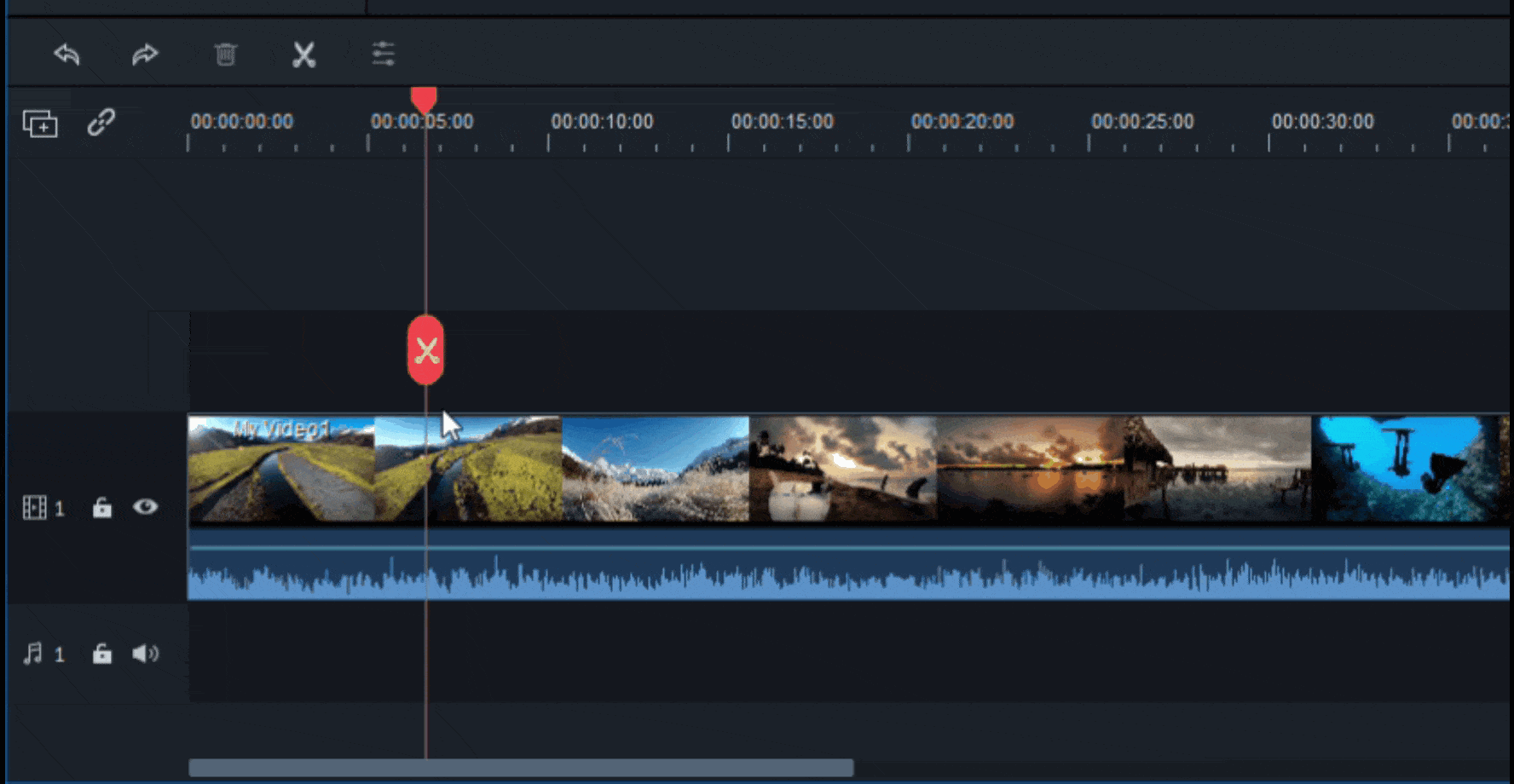1. Selecting and Searching Clips in the Media Library
1. To select a single media file: click on its thumbnail.
2. To select multiple media files: press and hold [Ctrl], and then click the thumbnails of the media you want to select.
3. To select a sequence of media files: click the first thumbnail in the sequence, press and hold [Shift], and then click the last thumbnail in the sequence.
Note: You can find a specific media file using the Search bar.

2. Deleting Media Files from the Media Library
In the Media Library, right-click on the clip you want to remove and select DELETE.
Note: When you delete a video clip or other piece of media from the Media Library, you are only removing it from Filmora and it won’t delete it from your computer or storage device.
3. Adding Videos and Other Media to the Timeline
Here are two ways to add media to the timeline:
Method 1: Find the video clip you want in the Media Library. Then, drag and drop it into your timeline.
Method 2: Right-click the video clip in the Media Library, and you will get:
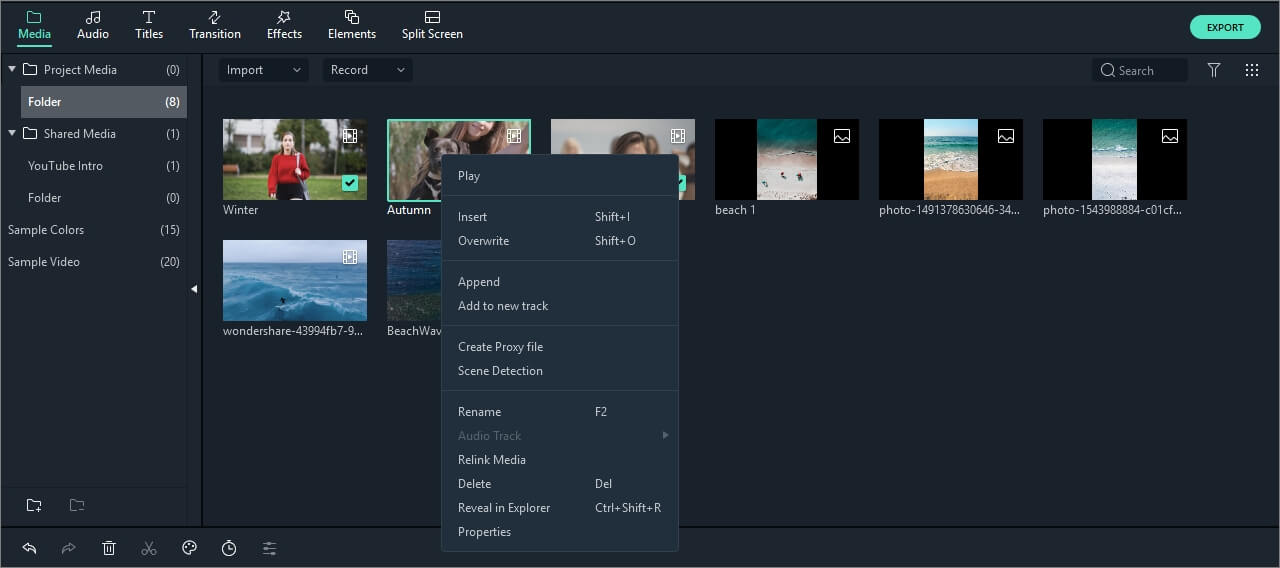
Insert: add your media to the selected track at the playhead. Any media that is already in the track on the right side of the inserted media will move to the right by the length of the inserted clip.
Overwrite: add your media to the selected track at the play head, and replace any media already occupying the space your added media takes up.
Append (add to the end): add your media as the last piece of media in the selected track.
Add to new track: add your media to a newly created track that has no other media.
Note: You cannot add media to tracks with Track Lock enabled.
4. Accessing Sample Colors and Sample Intro Video
Filmora includes several sample colors (still images of color) and countdown intro videos. To access these resources, click Media and choose Sample Colors or Sample Video.
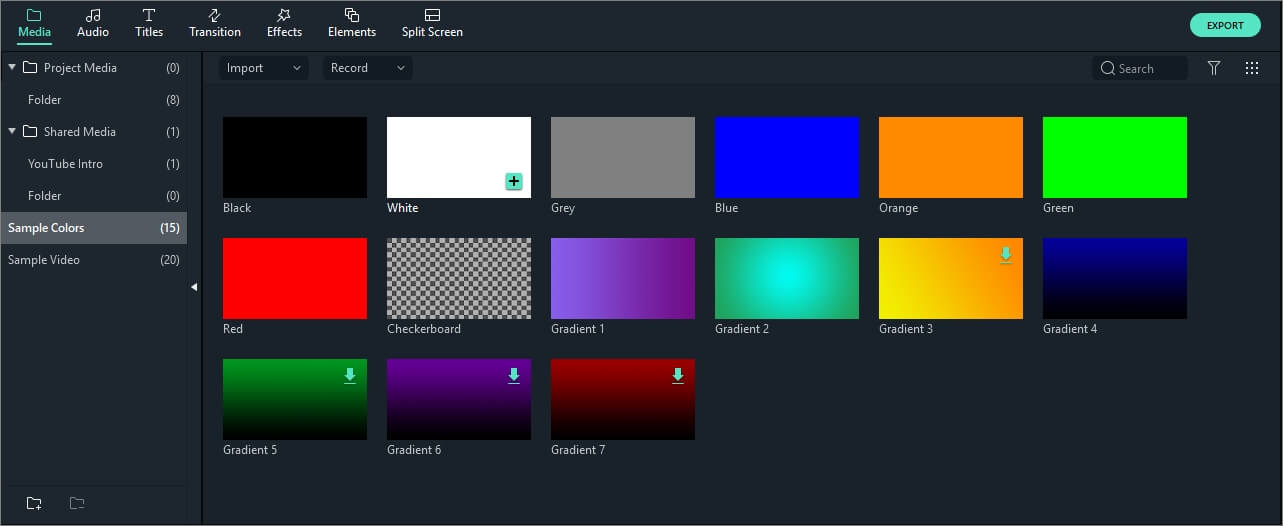
5. Deleting Clips from Timeline
To delete a single video clip or other pieces of media from your timeline, right click on the media in your timeline and select Delete, select the clip and hit the Delete icon in the toolbar, or select the clip and press the Delete key on your keyboard.
To remove multiple video clips or other pieces of media, press and hold CTRL, then select the target files. When you are done selecting, let go of CTRL and delete the items using the delete icon, the delete key on your keyboard, or by right-clicking and selecting delete.
Ripple Delete
Sometimes removing or deleting the video clips using the methods above will leave a big gap in the timeline. To avoid the gap, you can use the Ripple Delete feature.
Right click on the clip you need to remove (or hold down CTRL and select multiple pieces of media, then right-click) and then select Ripple Delete to remove that clip and have the remaining media in the track move over to fill the empty space.

6. Trim Video Clips
If you need to trim from the beginning or end of a video clip (or other pieces of media), hover your mouse over the left or right edge of the clip in your timeline until the trim tool shows. Then, click and drag the edge of your clip forwards or backward to trim off the unwanted portion.
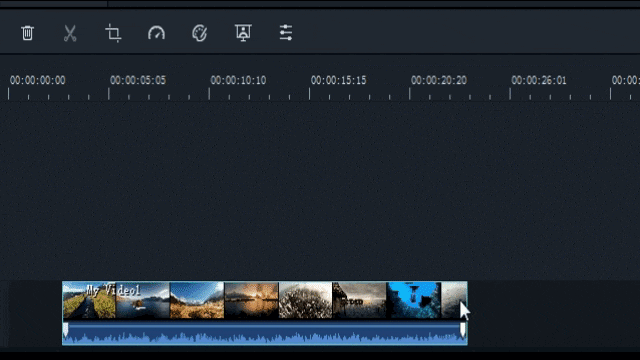
If you need to cut out a section in the middle of a video clip, drag the play head to the start point of the unwanted section and press the scissors icon to split the clip, then drag the play head to the end of the unwanted section and press the scissors again. Now that the unwanted section is on its own you can select it and press the delete icon to remove it.
Filmora also has an option for you to ‘quick trim’ from the start or end of a clip. In the timeline, place the played on the frame you want to trim to, right click on the clip, and select Trim Start to Playhead or Trim End to Playhead depending on whether you want to delete what’s behind the playhead or in front of it.

7. Splitting Video Clips
Split a clip manually on the timeline:
1. Drag the play head to the position where you want to split one or more clips and click the Split button (the red scissor icon) on the play head to create the split.
Note: If you don’t select a specific track in your timeline, you will split all of the clips under your play head. To split media in a single track, you need to select the track first and then click the Split icon.

2. You can also place the play head at the position where you want to split the clip, right-click, and choose Split.
Note: If you don’t like the red scissor button, you can go to File -> Preferences -> Editing to hide it.
![]()
8. Rotating or Flipping a Video Clip
To rotate or flip a clip:
1) Double click the clip in the Timeline.
2) In the popup Video panel, choose the Transform.
3) To rotate the clip, drag the rotate slider to the right or enter a numerical value in the rotate section to rotate the video as you want.
4) In the Flip section, click the Flip Horizontal icon to reverse the clip from left to right or click the Flip Vertical icon to turn the clip upside down.
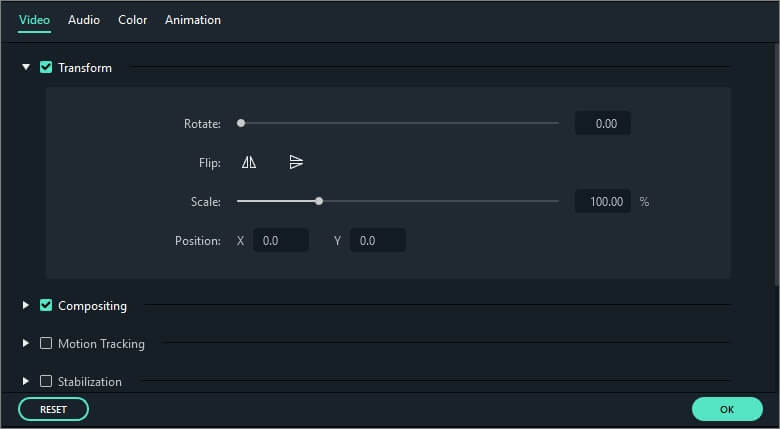
Click Reset to undo your changes or OK to apply the effect to your video.
Note: If you want to convert horizontal to portrait without cropping off the top or the bottom, you should right-click on the clip in the timeline and select Rotate 90 CW or Rotate 90 CCW directly. In this way, Filmora will rotate the video without cropping.

9. Cropping Video Clips
Follow the steps below to crop out and zoom into parts of your video clips:
1) Right-click on the clip in the timeline
2) Select the Crop and Zoom option from the menu or click the Crop icon to open the Crop and Zoon panel.
3) In the pop-up window, move and adjust the rectangle to surround the area you want to crop. You can also choose the preset from the following preset dimensions: 16:9, 4:3, 1:1, or 9:16. Or you can select Custom to crop the video with your own ratio.

10. Joining Videos
You can use the Join feature when you have several video clips in a sequence and want to combine them into one clip. To join videos clips, place them to the Timeline in the sequential order you want. They will be joined or combined as one video after export.
11. Copying & Pasting Video Clips
When you copy and paste clips in Filmora’s timeline, the spacing of the clips is kept. You can paste copies of the clip at the end of your video or insert them at the location of the play.
Step 1: Select one or more clips in the sequence, right-click, and choose Copy.
Step 2: In the timeline, position the played at the point where you want to paste a copy of the clips.
Step 3: Right-click and choose ‘paste’.
Note: If there are clips in the track before you paste, they might be overwritten by the pasted clips.
12. Enhancing Video Clips
Enhance your video clips by adjusting the white balance, tone, color, light, and HSL and by adding vignettes.
Double click the target clip in the timeline to enter the Edit panel, and select the Color menu, the window will show as below:

Drag the sliders respectively to adjust your color temperature, tint, contrast, saturation, and brightness. You can also enter a numerical value if you know the exact adjustment you want to make. There are also 3D LUT effects available if you want to change the entire look of your video at once. Watch the Preview Window see how the new settings affect the look of your video.
Click Advanced to enter the Advance Color Tuning panel where you’ll find presets as well as options to customize your colors, lighting, hues, saturation, luminance, vignettes, etc.
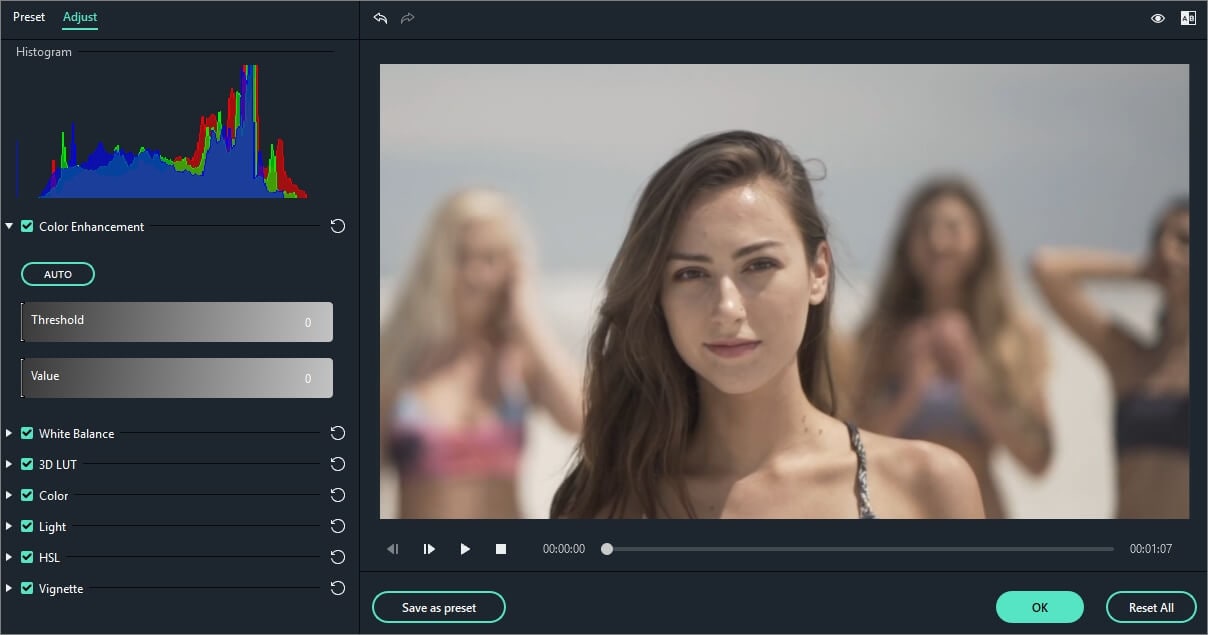
You can also enter the Advanced Color Tuning window by right-clicking a clip and then selecting Color Correction or clicking on the Color icon in the toolbar.
13. Changing Video Playback Speed
There are three ways to speed up or slow down a video clip in Filmora:
Method 1: Using the speed and duration settings:
Right-click on your clip in the timeline and select Speed and Duration to open the Custom Speed window. Drag the speed slider to adjust the speed of the video clip. You can also enter the precise video duration you want in the speed field. It will change the speed accordingly.
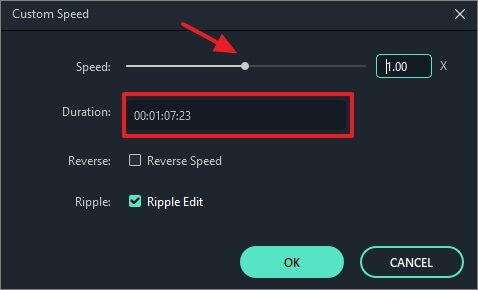
Note: the Reverse Speed option means to play the video backward.
Method 2: Using the custom speed panel:
Click the Speed icon in the toolbar. You’ll see options to slow down, speed up, or reverse the video. You can also return it to its normal speed if it has been altered. Filmora offers speed control presets so you can quickly slow your clip to 0.5x, 0.25x, 0.1x, 0.05x, or 0.01x the speed or speed it up to 4x, 8x, 20x, 50x or 100x faster.

Method 3: By manually dragging the video:
Press the Ctrl button on your keyboard, then hover the mouse over the end of a clip. You will see a round speed change icon.
While holding down the ‘Ctrl’ button, drag the edge of the clip backward to slow down the clip or forwards to speed it up.
After you slow down the clip, you will see a purple strip showing the speed change.

After you speed up the clip, you will see a red strip showing the speed change.

14. Creating Freeze Frames
A freeze-frame is a still image representing a single frame of your video clip. Usually, freeze frames are used to make it seem like time has stopped at a specific moment in your video. Here’s how to create a freeze-frame in Filmora:
- In the timeline, move the play head to the frame you want to freeze.
- Click the speed icon in the toolbar and select Freeze Frame.

- Set the duration of the freeze-frame by dragging its edge. You can also change the default duration freeze frames by going to File -> Preferences -> Editing.

15. Zooming in and out Timeline
To zoom in or out and see more or less (in more detail) of your timeline, use one of these methods:
- Find the Zoom in/out slider in the top right corner of the timeline. Drag it forwards to zoom in on the timeline and drag it back to zoom out.
- Click to zoom in on the Timeline or to zoom out.
- Click to automatically adjust the zoom to fit your entire timeline.
- Use the shortcut Ctrl + plus sign [+] to zoom in and Ctrl+ minus sign [-] to zoom out.
16. Resizing video clips
If you need to resize a video clip, drag and drop it into the timeline to cut out part of the video. Or, you can change the resolution, frame rate, and bit rate in the export window to lower the file size. If you need to change the display size of a video, use the Scale slider.
To access the Scale slider, right-click on the video clip you need to resize in the timeline choose Show Properties (Edit), and click into the Video tab in the popup window. Go to Transform and drag the Scale slider to the right or the left to resize the video clip. You can also enter an exact value if you know the exact percentage you want to scale to.
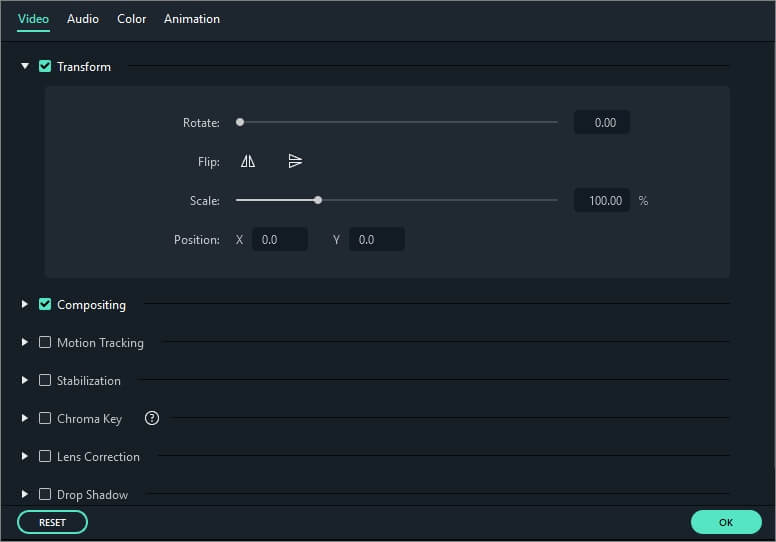
Click to check the details of how to resize video files.
17. Adding watermark/logo to the video
If you want to add a watermark/logo image to your video in the timeline, drag and drop the watermark/log to the video track (i.e Track 2) above the track (i.e Track 1) that places your video.
You can resize the watermark/logo image in the Preview Window by adjusting the small circles and squares at its edges, and move it to where you want in the Preview Window.
To adjust the opacity or blending mode of your watermark or logo (i.e. make it transparent), double click the logo image in the timeline to open the Image panel and go to Composition. From there you can choose a composition mode (i.e. darken) and use the Opacity slider to adjust your transparency.

18. Playback Quality
You can adjust the playback quality of the Preview window for a smoother editing experience. For example, you can improve the performance of your preview by playing your video at a lower resolution than you want for your finished project or by creating proxy media files to edit with.
Proxy files are more manageable versions of your clips that are easier to edit because they are smaller in terms of data (i.e. they are at a lower resolution). You can edit with a proxy file in Filmora, then export with your full-sized original clip.
Setting Playback Quality
If Filmora detects lags, it will prompt a message to ask you to lower playback quality.

Reducing your playback quality can eliminate lags and save you time. Click the playback quality control menu, and then choose from these options:

Full: preview your video without changing the original resolution
1/2: preview your video at 1/2 the original resolution
1/4: preview your video at 1/4 the original resolution
1/8: preview your video at 1/8 the original resolution
1/16: preview your video at 1/16 the original resolution
Note: the reduced playback resolution only applies to the video preview and will not affect the export settings.
19. Preview Render
Preview rendering reduces the preview lag which can occur when editing complex or high-resolution projects. This results in smoother playback. Filmora offers 2 ways to render your timeline preview:
Manual Render (The Render Button)
Click the Render Button to begin rendering your timeline whenever this red line appears (as when you add media or make other changes to your timeline).

The render preview window will pop up, showing the render progress and the estimated remaining time.
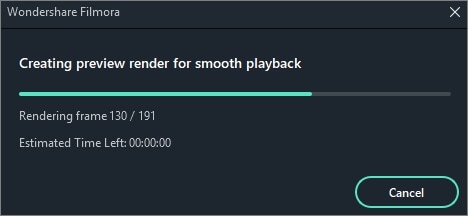
Once the rendering is complete, the red line will turn green.
Note: you will need to wait until the rendering process is finished to continue editing.
Auto-Render
Besides manually clicking the Render Button, you can also use a feature called Background Render. If you enable it, your videos will be rendered automatically when you add your videos to the timeline for editing. You can go to File-Preferences-Performance, set a starting time, and enable it. By default, the render process will be performed after 5 seconds of inactivity on the timeline.
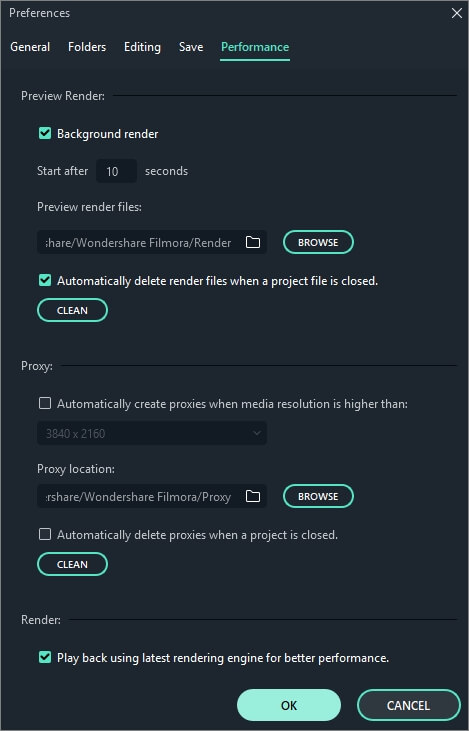
Click OK to save your settings.
Note: The rendered parts of your timeline will be indicated by a green line. The line will be red for the un-rendered parts. Once you change, modify, or add effects to the rendered section you’ll notice the line turning red to indicate you need to render again.
20. Ripple Edit
Click the Auto Ripple button to turn on ripple editing. This will allow you to trim, add, and delete clips without leaving a gap in your timeline. If you add new media in the middle of your timeline all of your clips and effects will be shifted to the right to accommodate the new addition.
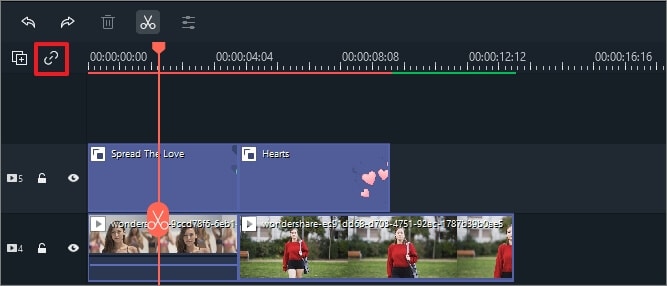

When auto-ripple is on you can automatically delete all of the effects applied to a clip when you delete the clip itself. Turn on auto ripple, select the video clip, right-click, and choose Delete.
21. Group Editing
Filmora allows you to link clips together as a group so you can move them without changing the positions relative to each clip within the group.
How to group clips
To combine multiple clips into a group, hold the Ctrl key on your keyboard and click the clips that you want to group in the timeline. Then, right-click the clip and select Group from the context menu.

Ungrouping Clips
To unlink your grouped clips, right-click one of the grouped clips in the timeline and select Ungroup.
Besides using the group feature, you can now mark the clip in the same color. Currently, you can mark the clip with eight colors, including red, orange, yellow, green, Cyan, blue, purple, gray, and white.
Right-click on the clip and select the option Select all clips with the same color mark, all clips in the same mark will be selected automatically, and then you can drag them as a group.

22. Closing Gaps between Videos
Sometimes there will be gaps between clips after you delete media on the timeline. To remove these gaps, first, you need to select all the videos with your mouse.

Then, right-click and select Close Gap

All the gaps will be removed.


